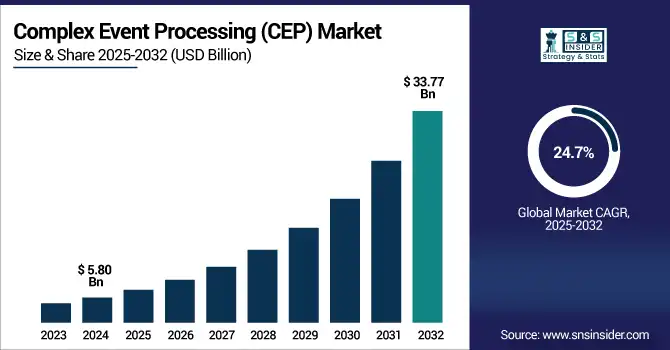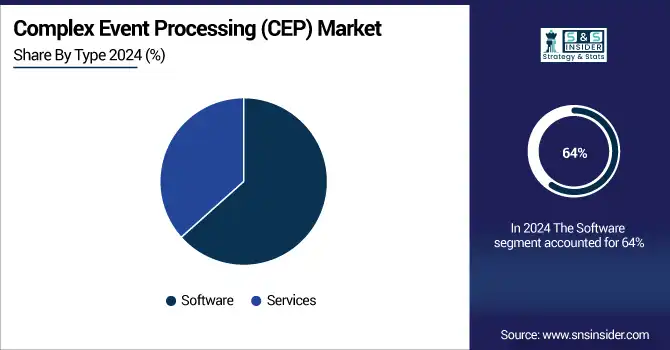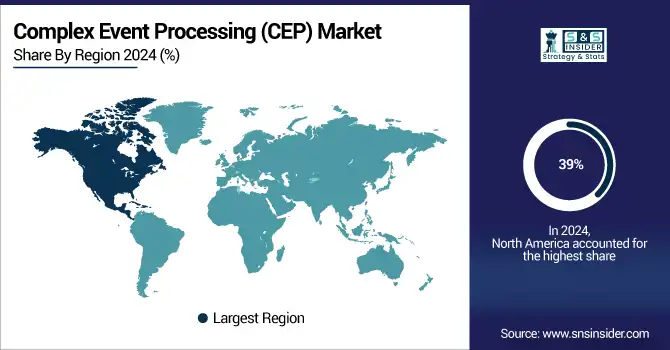Complex Event Processing (CEP) Market Report Scope & Overview:
The Complex Event Processing (CEP) Market Size was valued at USD 5.80 billion in 2024 and is expected to reach USD 33.77 billion by 2032 and grow at a CAGR of 24.7% over the forecast period 2025-2032.

To Get more information on Complex Event Processing (CEP) Market - Request Free Sample Report
The Complex Event Processing (CEP) market is undergoing significant change as more organizations across industries increasingly use real-time analytics to discover patterns, anomalies, and trends from high-velocity data streams. Three major benefits of CEP are processing multiple events in parallel, allowing for faster decision making, which is used in applications like fraud detection, operational monitoring, and predictive maintenance. Increasing application in various sectors like financial services, healthcare, manufacturing, and retail, and growing elements of AI, IoT, and Edge computing are providing the market with considerable growth. It covers behavioural market dynamics, the advancements in technology, the various trends in deploying systems, as well as the strategies of key vendors.
The U.S. Complex Event Processing (CEP) market size was USD 1.53 billion in 2024 and is expected to reach USD 7.18 billion by 2032, growing at a CAGR of 21.30% over the forecast period of 2025–2032.
The U.S. CEP market is primarily driven by the growing need for real-time data analytics in sectors such, finance, healthcare, & manufacturing. As AI gets more sophisticated and the IoT proliferates, the demand for quick judgment and seamless operation is on the rise. North America is led by the U.S. on account of its advanced technology infrastructure, high IT expenditure, and presence of the major CEP vendors. These considerations sharpen the competitive CEP deployment and innovation advantage least in the U.S., the region best positioned to take advantage of CEP solutions.
Market Dynamics
Key Drivers:
-
Growing Demand for Real-Time Data Analytics in Finance and Healthcare Drives Complex Event Processing (CEP) Market Growth
The primary driver of the Complex Event Processing (CEP) market is the surging need for real-time data analytics across the finance and healthcare sectors. These industries generate massive volumes of fast-moving data from transactions, sensor networks, and patient monitoring systems that require immediate processing to enable quick, accurate decisions. For example, financial institutions use CEP to detect fraudulent transactions instantly, minimizing losses and enhancing security. Similarly, healthcare providers utilize CEP for continuous patient monitoring and emergency response. A significant development reinforcing this trend was IBM’s launch of its real-time event processing platform in March 2023, designed specifically for high-frequency financial data. This advancement underscores the importance of CEP in managing complex, high-velocity data streams efficiently.
Furthermore, the proliferation of IoT devices and AI-driven analytics intensifies the demand for CEP systems capable of processing and analyzing data on the fly. Consequently, organizations prioritize CEP adoption to gain competitive advantages through operational agility and improved customer experiences, fueling steady market expansion globally.
Restrains:
-
High Complexity in Integrating CEP Systems with Existing Legacy IT Infrastructure Restrains Market Growth
The CEP market is the high complexity and cost associated with integrating CEP solutions into existing legacy IT infrastructures. Many enterprises operate on outdated systems that lack compatibility with modern CEP technologies, making seamless integration a challenging and resource-intensive process. This complexity leads to extended deployment timelines, increased costs, and sometimes operational disruptions. Additionally, legacy systems often lack the scalability and flexibility required to handle large volumes of real-time event data, which diminishes the effectiveness of CEP implementations. Enterprises face difficulties in modifying or replacing these systems due to budget constraints and risk aversion, further delaying CEP adoption. Moreover, the need for specialized skills to design, configure, and maintain CEP solutions adds to the barrier. Without adequate integration frameworks or standardized protocols, many organizations hesitate to fully embrace CEP technology, slowing down its broader market penetration despite growing demand.
Opportunities:
-
Expanding Edge Computing Applications Present Lucrative Growth Opportunities for CEP Market
The increasing adoption of edge computing is creating substantial growth opportunities for the Complex Event Processing (CEP) market, particularly as enterprises seek to process data closer to the source to reduce latency and bandwidth use. Edge computing enables CEP to analyze event streams generated by IoT devices and sensors in real time, facilitating faster decision-making in industries like manufacturing, smart cities, and autonomous vehicles. A recent opportunity-strengthening development occurred in January 2025 when Microsoft Azure announced updates to its edge computing platform, enhancing native CEP support to handle complex event patterns efficiently at the network edge. This development allows businesses to deploy CEP applications directly on edge devices, reducing dependence on centralized cloud infrastructure and improving responsiveness. As more organizations adopt edge computing to manage their growing IoT ecosystems, CEP solutions will be critical for real-time analytics, anomaly detection, and predictive maintenance. This shift toward decentralized event processing offers CEP vendors a chance to innovate and expand their market share across emerging use cases.
Challenges:
-
Data Privacy and Security Concerns Pose Significant Challenges to Widespread CEP Adoption Across Industries
The Complex Event Processing (CEP) market is addressing increasing data privacy and security concerns amid real-time data collection and processing. CEP systems continuously ingest and analyze vast amounts of sensitive information from diverse sources, including personal user data, financial transactions, and critical infrastructure monitoring. This exposure creates vulnerabilities to cyberattacks, data breaches, and compliance risks with stringent data protection regulations like GDPR and CCPA. Ensuring that CEP solutions incorporate robust security frameworks, such as encryption, access controls, and real-time threat detection, is complex and costly. Furthermore, organizations must navigate evolving legal requirements, which vary across regions and industries, complicating CEP deployment strategies. These concerns lead some enterprises to delay or limit CEP implementation to avoid potential liabilities. Vendors must balance performance with security, investing heavily in secure architectures and compliance certifications. Overcoming these challenges is crucial to building trust and encouraging broader adoption of CEP technologies globally.
Segmentation Analysis:
By Type
The Software segment holds the largest revenue share of 64% in 2024, driven by growing demand for advanced platforms that enable real-time processing of complex events. Continuous product enhancements focus on scalability, cloud integration, and improved event correlation, which support enterprises in handling high volumes of streaming data efficiently. The software solutions’ ability to provide fast analytics and decision-making capabilities makes this segment critical to the overall growth of the Complex Event Processing (CEP) market, as organizations prioritize data-driven agility and responsiveness.
The Services segment is expanding rapidly at a CAGR of 26.7%, fueled by increasing demand for professional consulting, system integration, and managed CEP solutions. Organizations require expert assistance to customize and deploy CEP platforms effectively, ensuring seamless integration with existing IT infrastructures. The complexity of real-time event processing drives the need for ongoing support and optimization services, making this segment vital in accelerating market adoption. Services enable businesses to maximize CEP benefits while overcoming technical and operational challenges.

By Enterprise Type
Large enterprises dominate with a 55% revenue share in 2024, leveraging extensive data resources and robust IT budgets to implement sophisticated CEP systems. Their need for high-volume data processing and real-time analytics supports complex use cases such as risk management and compliance. The scale and complexity of large organizations necessitate advanced CEP capabilities, reinforcing this segment’s leadership in the market. Continuous innovation in processing speed and event correlation further drives adoption among these enterprises.
The Small and Medium Enterprise (SME) segment is growing at a CAGR of 25.7%, benefiting from the increasing availability of affordable, scalable CEP solutions. SMEs are rapidly adopting real-time analytics to improve operational agility and customer responsiveness without heavy infrastructure investment. This segment’s expansion reflects the growing accessibility of CEP technologies, enabling smaller organizations to compete effectively in data-driven markets.
By End-user Vertical
The BFSI vertical leads the market with a 15% revenue share in 2024 due to its critical need for real-time fraud detection, risk management, and regulatory compliance. Real-time event processing is essential for monitoring financial transactions and identifying suspicious activities promptly. The vertical’s stringent operational requirements and data sensitivity drive demand for highly reliable and secure CEP solutions.
The Managed Mobility segment is growing rapidly at a CAGR of 27.13%, driven by the proliferation of IoT devices and connected vehicle technologies. Real-time event processing is crucial for managing distributed mobile networks, ensuring optimal resource utilization, and rapid issue resolution. The increasing complexity of mobile ecosystems fuels the demand for scalable CEP solutions that provide continuous monitoring and analytics. This vertical’s dynamic growth reflects expanding opportunities for CEP applications in emerging mobility and smart infrastructure domains.
Regional Analysis:
North America holds approximately 39% of the Complex Event Processing (CEP) market in 2024. Advanced technology infrastructure and high adoption of AI, IoT, and cloud computing drive CEP market dominance in North America. The United States dominates North America’s CEP market due to its robust IT ecosystem, extensive investments in research and development, and early adoption of cutting-edge technologies. Strong demand across financial services, healthcare, and manufacturing sectors for real-time analytics fuels growth. Additionally, the presence of major technology vendors and cloud service providers accelerates innovation and deployment of CEP solutions, reinforcing the U.S. leadership position in the regional market.
Asia Pacific is expected to grow at a CAGR of 31.01% during the forecast period. Rapid digital transformation, increasing IoT adoption, and government initiatives drive the fast growth of the CEP market in Asia Pacific. China leads the Asia Pacific CEP market due to its massive IoT deployment and digital infrastructure expansion. The government’s push for smart cities, Industry 4.0, and real-time data analytics accelerates CEP adoption. Growing industrial automation and e-commerce sectors increase demand for event processing to optimize operations and enhance customer experiences. Investments in AI and cloud technologies further strengthen China’s position as the regional CEP market leader.
Europe holds a significant share of the CEP market in 2024, driven by regulatory compliance needs and digital innovation across industries such as finance, manufacturing, and telecommunications. Strict data protection laws and Industry 4.0 adoption propel the CEP market growth in Europe, especially in Germany. Germany stands out as the dominant country due to its strong industrial base and early adoption of Industry 4.0 practices. The country’s emphasis on smart manufacturing and data-driven decision-making fuels CEP demand.
The Middle East & Africa and Latin America CEP markets are emerging regions witnessing steady growth in 2024. Increasing digital transformation initiatives and expanding IT infrastructure create new opportunities for CEP adoption. Governments are investing in smart city projects and improving data management capabilities to enhance public services. Though smaller compared to other regions, these markets show promising growth potential driven by rising demand for real-time analytics in sectors like telecommunications, energy, and finance.

Get Customized Report as per Your Business Requirement - Enquiry Now
Key Players:
The complex event processing (CEP) market includes IBM Corporation, SAP SE, Oracle Corporation, Tibco Software Inc., Software AG, SAS Institute Inc., Informatica Corporation, Nastel Technologies Inc., Espertech Inc., Cisco Systems Inc., and Others.
Recent Developments:
-
IBM announced the availability of the Event Processing Add-On for its Cloud Pak for Integration (CP4I). This add-on integrates Apache Flink-based event processing capabilities, allowing users to create and deploy event-driven solutions using a low-code visual editor.
-
SAP released SAP S/4HANA Cloud Private Edition 2023 FPS02, introducing advanced AI-assisted capabilities and expanding its digital assistant, Joule. Notably, the release includes AI-driven conversational planning in the transportation cockpit, allowing users to interact with the system using natural language for complex transportation decisions.
-
In 2024, Oracle announced the addition of AI Vector Search capabilities to its Database 23c. This feature introduces a new vector data type, vector indexes, and vector search SQL operators, enabling the database to store and query the semantic content of documents, images, and other unstructured data as vectors.
| Report Attributes | Details |
|---|---|
| Market Size in 2024 | USD 5.80 Billion |
| Market Size by 2032 | USD 33.77 Billion |
| CAGR | CAGR of 24.7% From 2025 to 2032 |
| Base Year | 2024 |
| Forecast Period | 2025-2032 |
| Historical Data | 2021-2023 |
| Report Scope & Coverage | Market Size, Segments Analysis, Competitive Landscape, Regional Analysis, DROC & SWOT Analysis, Forecast Outlook |
| Key Segments | • By Type (Software, Services) • By Enterprise Type (Small and Medium Enterprise, Large Enterprise) • By End-user Vertical (BFSI, Managed Mobility, Government and Defense, Retail, Healthcare, Telecom and IT Industry, Media and Entertainment, Manufacturing, Other End-user Verticals) |
| Regional Analysis/Coverage | North America (US, Canada, Mexico), Europe (Germany, France, UK, Italy, Spain, Poland, Turkey, Rest of Europe), Asia Pacific (China, India, Japan, South Korea, Singapore, Australia, Taiwan, Rest of Asia Pacific), Middle East & Africa (UAE, Saudi Arabia, Qatar, South Africa, Rest of Middle East & Africa), Latin America (Brazil, Argentina, Rest of Latin America) |
| Company Profiles | IBM Corporation, SAP SE, Oracle Corporation, Tibco Software Inc., Software AG, SAS Institute Inc., Informatica Corporation, Nastel Technologies Inc., Espertech Inc., Cisco Systems Inc., and Others. |

